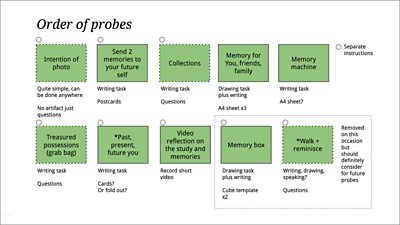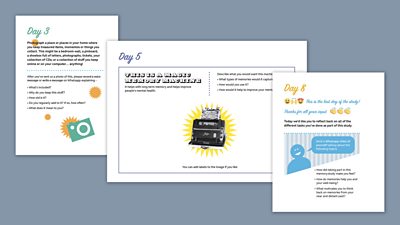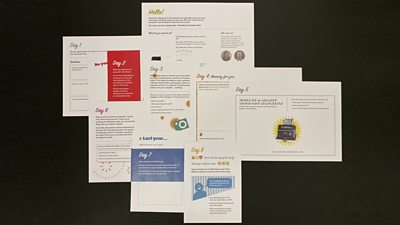
We were inspired to use cultural probes after a visit to the . The team showed us a selection of really thought-provoking projects but it was their use of in particular that really resonated with us. When we started our memory project, it felt like a good opportunity to use this design-led approach as part of the study.
Think broadly, with no restrictions
The memory study was kicked off during a 2-week design sprint. In week one, we conducted desk research and defined our research questions and in week two we focused on the design of the cultural probes.
Cultural probes are artefacts, activities and visual stimulus which investigate research areas in different and novel ways. They can be artefacts like disposable cameras, maps, postcards or notebooks and can elicit more interesting and inspirational responses, perhaps unearthing participantsβ deeper thoughts, culture and values.
On the first day of the design phase, the team were tasked to think of these two aspects but to think broadly and with no restrictions. Working together we considered research themes like public and private memories, motivations to reminisce and the value of digital and physical objects. We were prompted to think about artefacts like designing a poster, writing a news headline, drawing a map as well as activities which encouraged participants to use the space around them.
Make, test, iterate, test again and bin if not working!
After a lot of discussions and sketching, a number of broad ideas started to emerge. Over the next couple of days, we worked individually on ideas we felt strongly about. We rapidly made very low-fi paper prototypes and tested these with colleagues, family and friends. Testing with minimal verbal instruction was really important.
If there is one key lesson here, it is that a seemingly simple idea can become increasingly complex as it is transferred to an activity, especially when this activity will be done remotely. Test and iterate your ideas but if they aren't working, stop and start again.

Shape the study
After a few days, we had around 15 potential candidate probes. Based on how suitable and complex they were, we quickly narrowed them down to the 8 we needed. These were then mapped to the 8 days of the study.
It was important to create a nice rhythm and flow to the study, so we started with a very simple activity and ensured there was a good variety of writing, drawing and physical activities across the 2 weeks.
We also included a 'daily moments' task which required each participant to send a photo and short description of a memorable moment, big or small, from that day.

Final design
The final 8 cultural probes still had to be improved, refined and simplified. We designed high-fidelity versions, made small tweaks and ensured the instructions were as clear as possible. We also had to consider the design of the overall pack so started writing and designing the introduction and instructions for the whole study.

Once completed, we printed the probes on thin card. This is worth mentioning, as printing on heavier stock made the cultural probes look and feel nicer. The whole pack had a good weight to it and felt more substantial - we felt it communicated that we were serious about this study and hoped the participants would feel the same way too.
A late addition to the pack were some emoji stickers (which the participants were invited to keep afterwards). We asked the participants to stick any number of them on the cultural probes to express how they felt after completing them.
The final step in this preparation phase was postage and packaging (a rare task for those of us used to working digitally). We ensured we had 14 complete study packs, the correct participant addresses (there was one late change!), emoji stickers and, importantly, stamped and self-addressed envelopes.
We fed them into the post-box and crossed our fingers.

What did we learn?
The participants were very positive about the study and seemed engaged throughout. We had a 100% return rate with all participants completing every task. The participants were also incredibly open and honest about their lives and relationships.
Many commented on the physical form of the study and enjoyed writing about their memories. Simply making time in the day to pause and reflect on their lives was really valued and some saw the activities as therapeutic as it helped them see things from a different perspective. The emoji stickers were a surprise success too - participants liked having a non-verbal way of expressing how they felt.
The βdaily momentsβ task was less successful. In hindsight, our instructions could have been more specific. It was probably too open to interpretation and this confused some participants, worse still some felt slightly anxious about their submission, worrying whether it was actually their best moment of the day.

During the study, we set up a WhatsApp chat with each participant and this proved to be very beneficial. Being available and having informal chats with them every day softened the study, made it feel less like a test and more that they were involved in it with us.
Designing cultural probes is a really interesting challenge and has great creative opportunities. If your project or area of research has scope to explore and engage with the public in more open and subjective ways and your team is open to the challenge of designing artefacts to elicit these types of responses then we'd highly recommend using this methodology.
We will continue to design and use cultural probes, learning and improving as we go. Next time, we would love to find ways to make them even more fun, weird and provocative!
Find out more
Read part one of this blog, Designed for Life: Understanding Memories and Wellbeing in a Digital World and visit our , where we share our research findings in more detail.
A more in-depth website containing participant data is available for ΒιΆΉΤΌΕΔ staff only; contact us for access.

